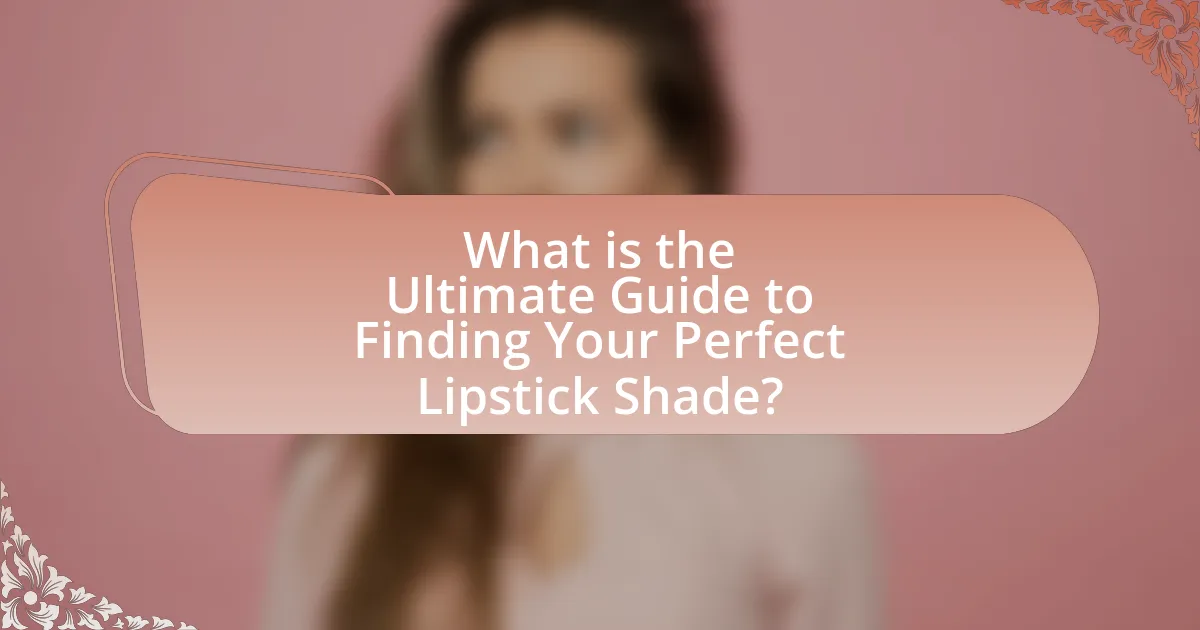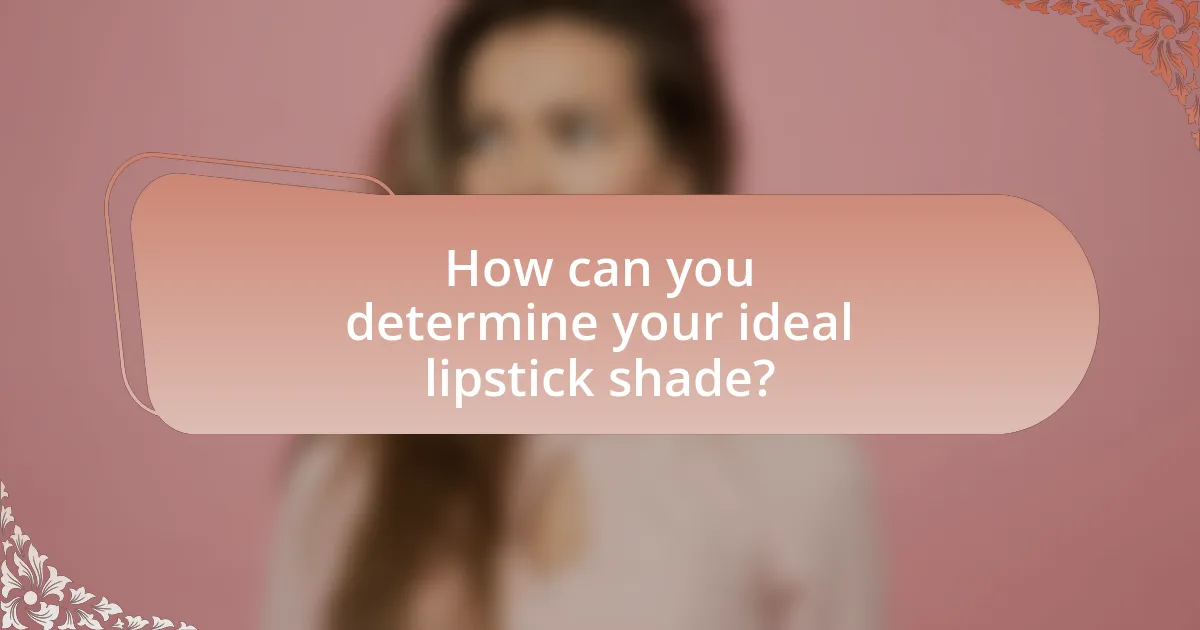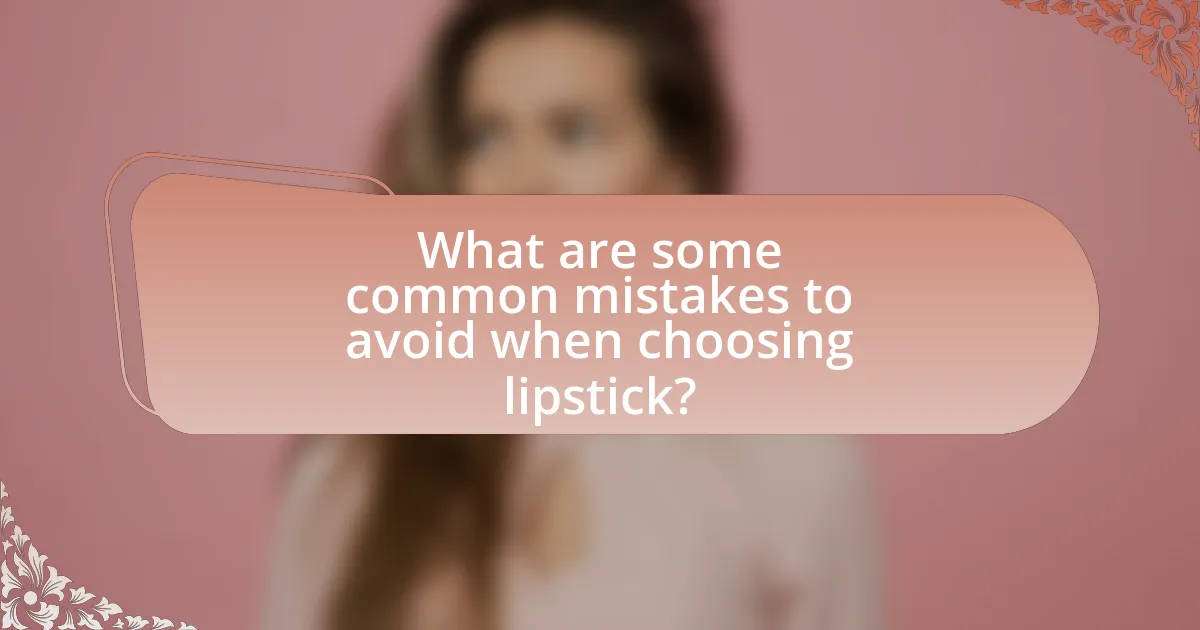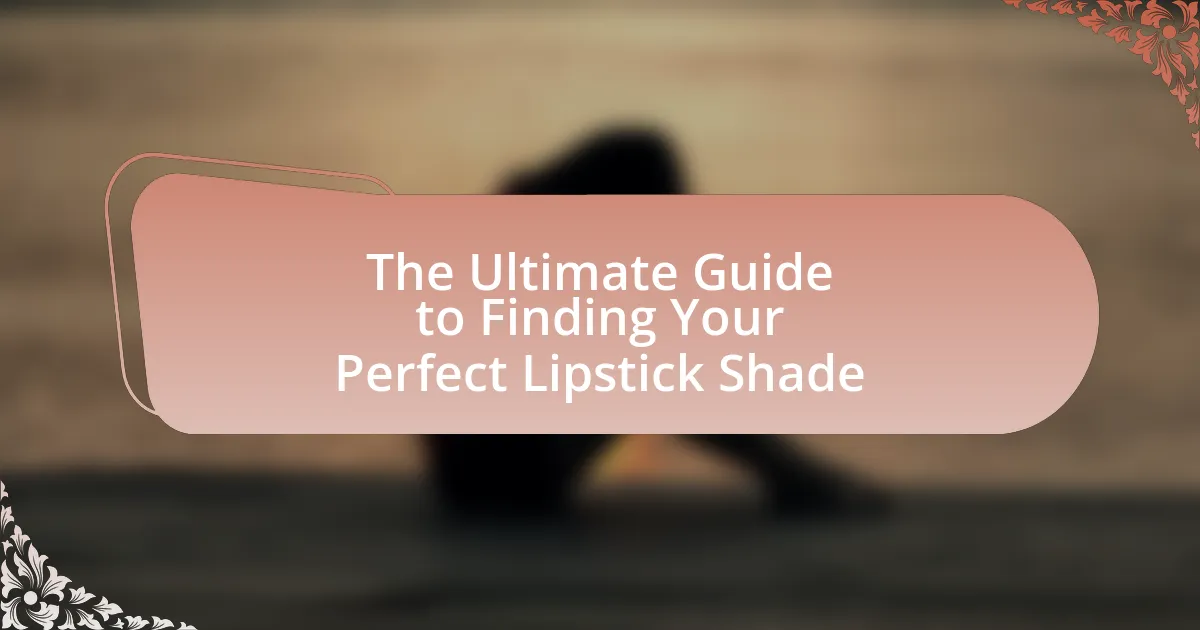The article provides a comprehensive guide to finding the perfect lipstick shade by examining key factors such as skin tone, undertone, and personal preferences. It emphasizes the importance of selecting shades that enhance natural beauty and boost confidence, supported by research on perceptions of attractiveness. The guide covers methods for determining ideal shades, the impact of natural lip color, and the significance of lipstick finishes. Additionally, it addresses common mistakes to avoid, seasonal trends, and best practices for application and maintenance, ensuring readers can make informed choices for their lipstick collection.

What is the Ultimate Guide to Finding Your Perfect Lipstick Shade?
The ultimate guide to finding your perfect lipstick shade involves identifying your skin tone, undertone, and personal preferences. First, determine if your skin tone is warm, cool, or neutral; warm tones typically pair well with peachy or coral shades, while cool tones suit berry or blue-based colors. Next, assess your undertone by examining the veins on your wrist: blue veins indicate a cool undertone, green veins suggest a warm undertone, and a mix indicates a neutral undertone. Additionally, consider the occasion and your outfit to select a shade that complements your overall look. This method is supported by beauty experts who emphasize the importance of matching lipstick shades to skin characteristics for a harmonious appearance.
Why is finding the perfect lipstick shade important?
Finding the perfect lipstick shade is important because it enhances an individual’s natural beauty and boosts confidence. A well-chosen lipstick shade complements skin tone, eye color, and overall makeup, creating a harmonious look. Studies show that wearing a flattering lipstick can positively influence perceptions of attractiveness and professionalism, as highlighted in research published in the Journal of Experimental Psychology, which found that women wearing red lipstick were perceived as more competent and attractive. Thus, selecting the right shade is crucial for personal expression and social interactions.
How does the right lipstick shade enhance your overall look?
The right lipstick shade enhances your overall look by complementing your skin tone and facial features, creating a harmonious appearance. When the lipstick color aligns with your natural coloring, it can brighten your complexion, define your lips, and draw attention to your eyes, thereby enhancing your overall aesthetic. For example, a study published in the Journal of Cosmetic Dermatology found that certain shades can improve perceived attractiveness and confidence levels, indicating that the right choice can significantly impact how others perceive you.
What role does lipstick play in personal expression?
Lipstick serves as a powerful tool for personal expression by allowing individuals to convey their personality, mood, and style through color and texture choices. The variety of shades and finishes available enables users to make bold statements or subtle enhancements, reflecting their unique identity. Research indicates that makeup, including lipstick, can significantly influence self-perception and confidence, as noted in a study published in the Journal of Experimental Social Psychology, which found that women who wore lipstick felt more attractive and self-assured. Thus, lipstick not only enhances physical appearance but also plays a crucial role in how individuals express themselves and perceive their own self-worth.
What factors should you consider when choosing a lipstick shade?
When choosing a lipstick shade, consider your skin tone, undertone, occasion, and personal style. Skin tone influences how colors appear; for example, fair skin often suits lighter shades, while deeper skin tones can carry bold colors. Undertones, whether warm, cool, or neutral, further refine choices; warm undertones pair well with corals and oranges, while cool undertones complement pinks and berries. The occasion also dictates shade selection; for professional settings, muted tones are preferable, whereas vibrant colors may be suitable for social events. Lastly, personal style reflects individual preferences and confidence in wearing specific shades. These factors collectively guide the selection process, ensuring a flattering and appropriate lipstick choice.
How do skin undertones affect lipstick selection?
Skin undertones significantly influence lipstick selection by determining which shades complement an individual’s natural coloring. Warm undertones, characterized by yellow or golden hues, typically pair well with lipsticks in coral, peach, and warm reds. Conversely, cool undertones, which exhibit pink or blue shades, are best suited for lipsticks in berry, plum, and blue-based reds. Neutral undertones can wear a broader range of colors, including both warm and cool shades. This correlation between undertones and lipstick shades is supported by color theory, which emphasizes that complementary colors enhance overall appearance and harmony.
What impact does your natural lip color have on shade choice?
Natural lip color significantly influences shade choice by determining how a lipstick will appear once applied. Lighter natural lip colors often require bolder or darker shades to create contrast, while deeper natural lip colors can be complemented with softer or more muted tones. Research indicates that the undertones of one’s natural lip color, such as warm or cool hues, also play a crucial role in selecting shades that enhance overall appearance. For instance, individuals with warm undertones may find that coral or peach shades suit them better, while those with cool undertones might prefer berry or plum shades. This alignment between natural lip color and lipstick shade ensures a harmonious look, making it essential for effective shade selection.
What are the different types of lipstick finishes available?
The different types of lipstick finishes available include matte, satin, glossy, sheer, and metallic. Matte lipsticks provide a flat, non-shiny finish and are known for their long-lasting wear, while satin finishes offer a slight sheen and a more moisturizing feel. Glossy lipsticks deliver a high-shine appearance, enhancing the lips’ fullness, and sheer lipsticks provide a light wash of color with a translucent finish. Metallic lipsticks contain shimmer or glitter particles, creating a reflective effect. Each finish serves distinct aesthetic preferences and occasions, catering to diverse makeup styles.
What are the characteristics of matte lipsticks?
Matte lipsticks are characterized by their non-shiny, flat finish that provides a bold and sophisticated look. They typically have a higher pigment concentration, which results in intense color payoff and long-lasting wear. Additionally, matte lipsticks often contain waxes and oils that help them adhere to the lips without the glossy sheen found in other formulations. This formulation can lead to a drier feel on the lips compared to creamy or glossy lipsticks, but many brands now include moisturizing ingredients to enhance comfort.
How do glossy lipsticks differ from satin finishes?
Glossy lipsticks provide a high-shine finish that reflects light, creating a wet look, while satin finishes offer a softer sheen with a more muted appearance. The glossy formula typically contains more emollients and oils, resulting in a moisturizing effect and a vibrant color payoff, whereas satin lipsticks balance between matte and glossy, providing a comfortable wear without excessive shine. This distinction is evident in product formulations; for instance, glossy lipsticks often include ingredients like castor oil for shine, while satin finishes may use a blend of waxes and oils to achieve their characteristic look.

How can you determine your ideal lipstick shade?
To determine your ideal lipstick shade, assess your skin tone, undertone, and personal preferences. Skin tones can be categorized as fair, medium, or deep, while undertones are typically warm, cool, or neutral. For example, individuals with warm undertones often look best in shades like coral or peach, while those with cool undertones may prefer berry or blue-based reds. Additionally, testing shades in natural light and considering the occasion can further refine your choice. Research indicates that understanding these factors significantly enhances the likelihood of selecting a flattering lipstick shade.
What methods can help you identify your perfect shade?
To identify your perfect lipstick shade, you can use methods such as color matching, skin tone analysis, and testing swatches. Color matching involves comparing shades against your natural lip color to find a complementary hue. Skin tone analysis categorizes individuals into warm, cool, or neutral tones, guiding them toward shades that enhance their complexion. Testing swatches on your lips or wrist allows for a practical assessment of how the color appears against your skin. These methods are effective because they consider both personal features and color theory, ensuring a more tailored selection.
How can swatching help in finding the right lipstick?
Swatching helps in finding the right lipstick by allowing individuals to test the color and texture directly on their skin. This hands-on approach provides immediate visual feedback, enabling users to see how the shade complements their skin tone and undertones. Research indicates that skin undertones significantly influence how a lipstick shade appears; for example, warm undertones often pair well with coral and peach shades, while cool undertones suit berry and blue-based colors. By swatching, consumers can also assess the formula’s finish—matte, satin, or glossy—ensuring it aligns with their preferences. Thus, swatching is a practical method for making informed lipstick choices based on personal aesthetics and skin compatibility.
What tools can assist in shade matching?
Color matching tools such as color swatches, shade-matching apps, and digital color analyzers can assist in shade matching. Color swatches provide a physical reference for comparing lipstick shades against skin tones, while shade-matching apps utilize augmented reality to simulate how different shades will appear on the lips. Digital color analyzers can assess skin undertones and suggest complementary lipstick shades based on precise color data. These tools enhance the accuracy of shade selection, ensuring a better match for individual preferences and skin tones.
How do seasonal trends influence lipstick choices?
Seasonal trends significantly influence lipstick choices by dictating color palettes and finishes that align with the mood and aesthetics of each season. For instance, during spring, consumers often gravitate towards lighter, pastel shades, while fall typically sees a rise in deeper, richer hues like burgundy and plum. This shift is supported by fashion industry reports, such as the Pantone Color Institute’s seasonal color forecasts, which highlight trending colors that resonate with consumers’ seasonal preferences. Additionally, seasonal marketing campaigns from major cosmetic brands often reflect these trends, further guiding consumer choices and reinforcing the connection between seasonal changes and lipstick selection.
What shades are popular in different seasons?
In spring, popular lipstick shades include soft pinks and corals, reflecting the blooming flowers and fresh beginnings. Summer favors vibrant colors like bright reds and fuchsias, aligning with the lively and energetic atmosphere of the season. In autumn, deeper hues such as burgundy and plum become trendy, mirroring the changing leaves and cozy vibes. Winter often sees the rise of bold shades like classic red and deep berry, suitable for festive occasions and holiday gatherings. These seasonal preferences are influenced by fashion trends and cultural events, making them relevant to consumers seeking to match their lipstick choices with the time of year.
How can you adapt your lipstick wardrobe for seasonal changes?
To adapt your lipstick wardrobe for seasonal changes, select shades that reflect the mood and colors of each season. For spring and summer, opt for lighter, brighter shades like corals and pinks, which align with the vibrant nature of these seasons. In contrast, during fall and winter, choose deeper, richer tones such as burgundy and plum, which complement the darker palettes typically associated with colder months. This approach is supported by color theory, which suggests that colors can evoke specific emotions and align with seasonal aesthetics, enhancing overall appearance and mood.

What are some common mistakes to avoid when choosing lipstick?
Common mistakes to avoid when choosing lipstick include selecting shades that do not complement your skin tone, ignoring the finish and texture of the lipstick, and failing to consider the occasion. Choosing a lipstick shade that clashes with your undertones can lead to an unflattering appearance; for instance, warm undertones typically look best with warm shades like corals and oranges, while cool undertones suit pinks and berries. Additionally, the finish—matte, satin, or glossy—affects the overall look and feel; for example, matte lipsticks can be drying, which may not be suitable for everyone. Lastly, neglecting to match the lipstick to the event can result in inappropriate choices, such as bold colors for formal settings or overly casual shades for professional environments.
What pitfalls should you be aware of in lipstick selection?
When selecting lipstick, be aware of the pitfalls of choosing shades that do not complement your skin tone. Many individuals mistakenly select colors based solely on trends or packaging rather than considering their undertones, which can lead to unflattering results. For instance, warm undertones typically pair well with coral and peach shades, while cool undertones are better suited for berry and blue-based colors. Additionally, ignoring the formula can also be detrimental; for example, matte lipsticks may emphasize dryness on the lips, while glossy formulas can highlight imperfections. Understanding these factors can significantly enhance the effectiveness of your lipstick selection.
How can lighting affect your lipstick choice?
Lighting significantly affects lipstick choice by altering how colors appear on the lips. Different lighting conditions, such as natural daylight, fluorescent, or incandescent light, can change the perception of a lipstick’s shade, making it look lighter, darker, or even different in hue. For instance, natural light tends to show the true color of the lipstick, while artificial lighting can distort it, leading to a mismatch between how the lipstick looks in the store and how it appears in various environments. Studies in color theory indicate that lighting can influence color perception by up to 30%, emphasizing the importance of testing lipstick shades in the lighting conditions where they will be worn.
What are the risks of following trends blindly?
Following trends blindly can lead to several risks, including poor personal choices and financial loss. Individuals may purchase products that do not suit their unique skin tone or personal style, resulting in dissatisfaction and waste. For instance, a study by the American Psychological Association indicates that conformity to social trends can diminish self-esteem and lead to regret over impulsive purchases. Additionally, trends often change rapidly, which can result in spending on items that quickly become outdated, leading to unnecessary financial strain.
What tips can help you maintain your lipstick collection?
To maintain your lipstick collection effectively, store lipsticks in a cool, dry place away from direct sunlight to prevent melting and color fading. Regularly check for expiration dates, as most lipsticks have a shelf life of 1 to 3 years, and discard any that show signs of separation, changes in texture, or unusual odors. Additionally, clean the lipstick bullet with a tissue after each use to prevent contamination and ensure longevity. These practices help preserve the quality and usability of your lipsticks, ensuring they remain in optimal condition for application.
How should you store your lipsticks for longevity?
To store lipsticks for longevity, keep them in a cool, dry place away from direct sunlight and heat sources. High temperatures can cause the lipstick to melt or change texture, while humidity can lead to bacterial growth. Storing lipsticks in a temperature-controlled environment, ideally between 60°F to 75°F, helps maintain their consistency and effectiveness. Additionally, using airtight containers can further protect them from moisture and air exposure, which can degrade the product over time.
What is the best way to clean and sanitize your lipstick products?
The best way to clean and sanitize your lipstick products is to use isopropyl alcohol or a disinfectant spray specifically designed for cosmetics. First, remove the lipstick from its tube and wipe the surface with a cotton pad soaked in isopropyl alcohol, ensuring that all areas are covered. This method effectively kills bacteria and viruses, as isopropyl alcohol is known to eliminate 99.9% of germs. Additionally, for lip gloss or liquid lipstick, spray the applicator with the disinfectant and allow it to dry before use. Regular cleaning helps maintain hygiene and prolongs the life of the product.
What are the best practices for applying lipstick for a flawless finish?
To achieve a flawless finish when applying lipstick, start by exfoliating your lips to remove dead skin, ensuring a smooth base. Next, apply a lip balm to hydrate and prep the lips, followed by a lip liner that matches your lipstick shade to define the lip shape and prevent feathering. After that, use a lipstick brush for precise application, filling in the lips evenly. Blot with a tissue and apply a second layer for longevity. Finally, use a translucent powder to set the lipstick and enhance its durability. These steps are supported by makeup artists who emphasize the importance of preparation and layering for a polished look.
How can lip liner enhance your lipstick application?
Lip liner enhances lipstick application by providing a defined boundary that prevents feathering and bleeding of the lipstick. This precise outline allows for a more controlled application, ensuring that the lipstick stays within the desired lip shape. Additionally, using a lip liner that matches the lipstick shade can create a seamless transition, enhancing the overall look. Studies indicate that lip liners can increase the longevity of lipstick wear, as they act as a barrier that helps to lock in color and moisture, thus maintaining a fresh appearance throughout the day.
What techniques can ensure even application and longevity?
To ensure even application and longevity of lipstick, techniques such as exfoliation, priming, and layering are essential. Exfoliating the lips removes dead skin cells, creating a smooth surface for lipstick application. Using a lip primer helps to fill in fine lines and provides a base that enhances adherence, which can extend wear time. Additionally, applying lipstick in thin layers allows for better blending and prevents caking, while setting the final layer with a translucent powder can lock in the color for longer-lasting results. These methods are supported by beauty experts who emphasize the importance of preparation and technique in achieving a flawless lip look.

